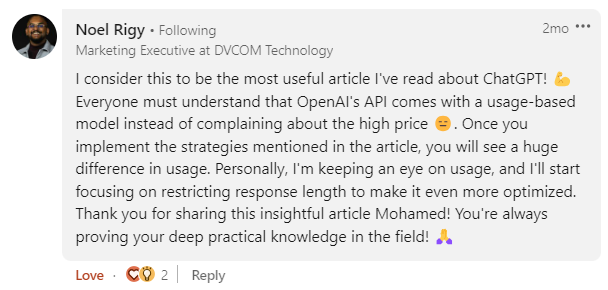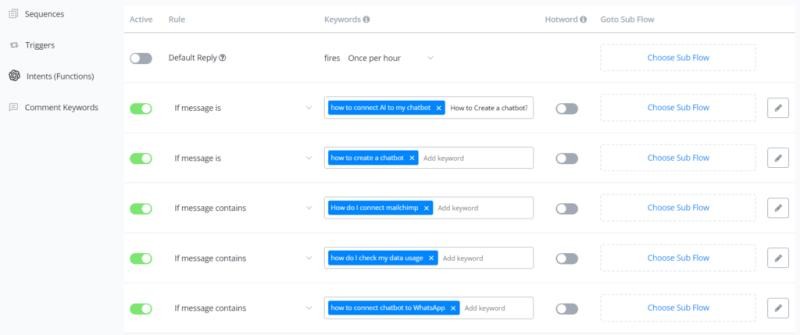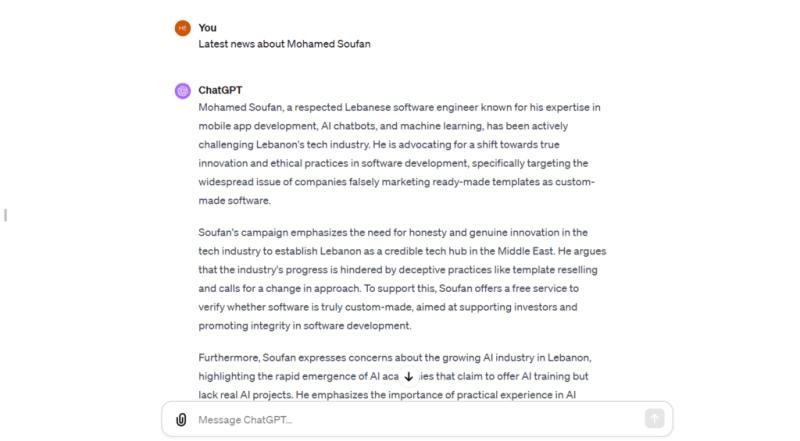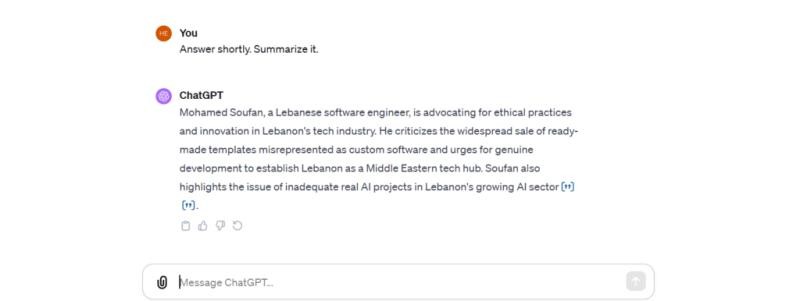Optimizing ChatGPT API Usage: Strategies for Cost Reduction Without Compromising Quality

In today’s digitally-driven world, artificial intelligence, particularly OpenAI’s ChatGPT, has emerged as a game-changer in various industries. However, as with any powerful tool, its usage comes with a cost. This article aims to demystify the often-daunting task of reducing ChatGPT API cost, offering practical and effective strategies to optimize and reduce expenses without affecting quality.
Whether you’re a small business owner, a developer, or simply an AI enthusiast, these insights will empower you to leverage ChatGPT’s capabilities more efficiently, ensuring you get the most out of this incredible technology without breaking the bank.
Understanding The Pricing Model
Token-based pricing
ChatGPT API Cost is based on how much you write or read. Think of it like buying text in bulk. For every 1,000 ‘pieces’ of text (called tokens), which is about 750 words, you pay a small fee, like $0.002. Therefore, the more you write, the more tokens you use, and the more you pay.
ChatGPT API Cost is 0.2 cents for every 1000 tokens used. Since 750 words of text usually equal 1000 tokens, it will cost you 0.2 cents to generate about 750 words. Additionally, there are some methods you can apply to lower this expense.
For a clearer understanding of ChatGPT’s cost structure and how it impacts your usage, I highly recommend reading the accompanying article before proceeding:
Price of GPT API Simplified: Real Examples and Case Studies
You pay for what you use.
ChatGPT operates on a usage-based pricing model, meaning you pay a small fee each time you use the API. Consequently, this is not a fixed-price model. The costs for each project vary depending on how the ChatGPT API is implemented and utilized.
Unnecessary API cost
The downside of this pricing model is the potential for incurring costs for unnecessary usage. Consequently, without a clear understanding of how to effectively utilize this model, you may end up paying for services you don’t need at prices beyond your budget.
Reducing ChatGPT API cost
1. Understand your usage

Let’s start by getting a handle on how much you’re really using the ChatGPT API. Think of it like checking your phone data usage — you want to know where those bytes are going! Subsequently, by diving into your API call logs, you can spot which parts of your service are chatting with ChatGPT the most. Are there frequent, small talks, or occasional deep conversations? Understanding this pattern is key.

Keep a close eye on your API usage; it’s the first step towards smart savings!
2. Store repeated answers

Imagine you have a chatbot that uses ChatGPT to answer customer queries. If you notice that the same questions are asked often, it means you’re making repeated trips to the API for answers you already have. Therefore, it’s like asking your friend the same question over and over — not the best use of time or resources, right?
Make sure to store the repeated answers generated by GPT each time they are triggered. This will help you avoid paying for tokens every time the same queries are made. By doing so, you can respond to these questions without incurring additional API fees.

As you can see in the screenshot above, I store repeated answers in my chatbot manager to avoid using ChatGPT’s API each time a user asks those questions. Therefore, this effectively helps me to reduce ChatGPT API cost every day.
3. Limit response length

Think of ChatGPT responses like tweets: sometimes, the shorter, the better! By setting a limit on the length of responses from the API, you’re essentially telling ChatGPT, “Hey, keep it concise!” This not only saves tokens (and money) but often leads to more straightforward, to-the-point answers.
Here’s a quick example:
Imagine you’re using ChatGPT in your e-commerce chatbot to generate product descriptions for your online store. Without a limit, you might get a charming but lengthy tale about each product. Fun? Yes. Cost-effective? Not so much. By setting a character or token limit, ChatGPT gets right to the heart of what makes your product special, giving you snappy descriptions that won’t break the bank.
ChatGPT answer without a limit:

ChatGPT answer with a limit:

4. Write concise prompts
Welcome to the art of brevity! Writing concise prompts for ChatGPT is like packing for a weekend trip with just a backpack – it challenges you to bring only what you truly need. The goal? To convey your message to ChatGPT as efficiently as possible, using fewer words and, therefore, fewer tokens.
Let’s break it down with an example:
Suppose you’re developing a chatbot for customer support. Instead of asking ChatGPT, “Can you provide me with a detailed explanation of how customers can reset their passwords if they have forgotten them?”, try “How to reset forgotten password?” This shorter prompt cuts straight to the chase, reducing token usage and saving costs, without sacrificing the quality of the response.
Remember, in the world of API calls, less is often more. Each word is a passenger; make sure everyone on board is essential!
5. Logic-based API triggers

Welcome to the smart world of logic-based API triggers! This is where you turn into a savvy strategist, using intelligent triggers to decide when to call upon ChatGPT. It’s like having a wise gatekeeper who knows exactly when to open the doors to the API, ensuring you use it only when truly necessary.
Here’s how it works:
Imagine having a chatbot that uses GPT-4 for image analysis to suggest outfit colors. If a user sends an image, GPT-4 is automatically triggered. Otherwise, the chatbot can employ a more cost-effective model to respond to text messages.

Think of it as a filtration system – you only let the most complex, value-adding questions pass through to the API. This smart approach helps you conserve resources, reducing unnecessary calls and focusing your ChatGPT usage where it adds the most value.
6. Combine multiple requests
Dive into the efficiency of batch processing, where combining multiple requests into a single API call is like making a smoothie with all your favorite fruits at once! This approach is not only time-efficient but also cost-effective, as it reduces the number of individual API calls you need to make.
Imagine this scenario:
You’re running a news aggregation service that uses ChatGPT to summarize articles. Instead of sending a request for each article, batch them together. Send a group of articles in one go and receive a bundle of summaries back. It’s like asking a friend to bring you a week’s worth of groceries in one trip, instead of going to the store every day.
By batching requests, you’re streamlining the process, conserving API tokens, and making the most out of each interaction with ChatGPT. It’s a clever way to get more for less!
Let’s illustrate with an example:
Imagine you’ve integrated ChatGPT into a customer service bot. A customer asks, “What’s the return policy?” Rather than receiving a long-winded answer, you set a token limit to ensure ChatGPT provides a brief yet complete response. This way, the customer gets their answer quickly and succinctly, and you conserve valuable tokens with each query.
Adopting this approach is like fine-tuning a musical instrument: you adjust until you hit the perfect note, ensuring your ChatGPT interactions are harmonious with both user needs and budget constraints for a lower ChatGPT API cost.
7. Plan API calls strategically
Mastering the art of strategically planning your ChatGPT API calls is akin to being a skillful chess player. Each move (or API call) should be thoughtfully considered for its impact and necessity. Thus, this approach involves anticipating your needs and organizing interactions with the API in the most efficient way possible.
Consider this scenario:
You’re developing an educational app that uses ChatGPT to provide study assistance. Instead of making spontaneous API calls every time a student asks a question, you could accumulate questions over a period (say, an hour) and then send them in batches. This way, you’re not just reacting to immediate demands but proactively managing your API usage.
Implementing strategic planning for your API calls is like packing for a trip; by carefully planning what you need, you ensure that every item (or API call) serves a purpose and contributes to a smoother journey. This method not only optimizes your API usage but also leads to a more organized and cost-effective operation that reduces ChatGPT API Cost.
8. Adjust strategies based on analytics
Adapting your ChatGPT API usage based on analytics is like being a navigator charting a course through ever-changing seas. Accordingly, by regularly analyzing your API usage data, you gain valuable insights that guide you in fine-tuning your strategies for efficiency and cost-effectiveness.
Here’s how:
Imagine you’re running a customer support chatbot. By examining your usage analytics, you might discover that certain times of day have higher query volumes. With this knowledge, you could adjust your API usage to handle simpler queries locally during peak hours and reserve ChatGPT for more complex questions.
For example, in an e-commerce setting, analytics might reveal that certain product inquiries are more frequent. Using this insight, you could optimize the ChatGPT integration to automatically handle these common queries more efficiently, reserving more complex and varied customer interactions for the API. This data-driven approach ensures you’re using the ChatGPT API effectively, aligning expenditure with actual needs and maximizing the value of each interaction, and reducing ChatGPT API Cost.
9. Select the right pricing plan
Navigating through different pricing plans for ChatGPT’s API is a critical step in aligning your usage needs with your budget. Consequently, this process is about finding a balance between the functionalities you require and the costs you can afford, much like choosing a mobile data plan that fits your usage pattern.
Start by comparing the various plans offered. Look at factors like the number of tokens per plan, the cost per thousand tokens, and any additional features or limits each plan has. Consider not only your current needs but also anticipate future usage as your project scales.
Example:
A startup might initially lean towards a basic plan due to budget constraints. However, as the startup grows and the demand for more complex ChatGPT interactions increases, it may become more cost-effective to switch to a higher-tier plan that offers a lower cost per token at a higher volume.
Selecting the right plan requires a careful evaluation of how often and in what ways you’re using the ChatGPT API. This decision is crucial as it directly impacts your operational costs and the overall efficiency of your service. Regularly review your plan choice and be ready to adjust as your needs evolve, ensuring that you always have the most suitable plan for your specific requirements.
10. Pre-process and post-process ChatGPT responses
Harnessing the power of local processing both before and after ChatGPT API calls is a smart strategy to maximize efficiency and minimize costs. It’s like having a skilled assistant who prepares and refines everything ChatGPT handles, ensuring that every interaction with the API is both necessary and optimized.
Preprocessing:
Preprocessing involves preparing your data before sending it to ChatGPT. This could mean condensing long paragraphs into key points or filtering out simple queries that can be handled locally. It’s like tidying up your house before a guest arrives; you want to make their stay (or in this case, the API’s work) as smooth and straightforward as possible.
Post-processing:
post-processing is about taking ChatGPT’s responses and fine-tuning them to fit your specific needs. This could involve summarizing long answers or integrating them into your application in a user-friendly manner. Consider it like adding your personal touch to a letter before sending it out: you’re making sure it conveys exactly what you want in the most effective way.
By implementing these preprocessing and post-processing steps, you’re not just blindly relying on ChatGPT for every task. Instead, you’re thoughtfully using the API where it adds the most value, saving resources and enhancing the overall quality of your application. This approach ensures a more efficient, tailored use of ChatGPT, aligning it perfectly with your specific needs and constraints.
FAQs: Reducing ChatGPT API Cost
What is ChatGPT's API pricing model?
ChatGPT uses a usage-based pricing model, where costs are incurred based on the number of tokens processed in each API call.
How reducing ChatGPT API cost works?
To reduce costs, consider strategies like caching responses, batching requests, crafting concise prompts, and setting limits on response length.
What is the benefit of caching responses in ChatGPT?
Caching saves common responses, reducing the need for repeat API calls and thus lowering costs.
How does setting a response length limit in ChatGPT save costs?
Setting a response length limit reduces the number of tokens processed per query, thereby lowering the cost per API call.
How often should I review my ChatGPT API usage strategy?
Regularly reviewing and adapting your API usage strategy is recommended to ensure continued efficiency and cost-effectiveness.
Conclusion: Reducing ChatGPT API Cost
As we wrap up our journey through optimizing ChatGPT API costs, let’s take a moment to recap the key strategies we’ve explored. In summary, remember, the goal is to strike a balance between maximizing the powerful capabilities of ChatGPT and managing your resources wisely.
Recap: How to reduce ChatGPT API cost?
- Be Strategic with Your Usage: Understand when and how often you’re calling the API.
- Cache Like a Pro: Store repeated answers to avoid unnecessary calls.
- Craft Concise Prompts: Less is more when it comes to crafting effective prompts.
- Smart Triggering: Use logic-based triggers to decide when to call the API.
- Batch for Efficiency: Combine multiple requests to reduce the number of calls.
- Limit Responses: Set response length limits to save tokens.
- Plan Wisely: Choose a pricing plan that aligns with your usage patterns.
- Local Processing: Utilize preprocessing and post-processing to minimize API reliance.
But the journey doesn’t end here. The digital landscape is ever-evolving, and so should your strategies. Regularly review your usage patterns, stay updated with ChatGPT’s updates and pricing changes, and be ready to adapt your approach. This isn’t just about cutting costs; it’s about embracing a mindset of continuous improvement and efficiency.
Your journey with ChatGPT is unique, and with these strategies in hand, you’re well-equipped to navigate it successfully. Keep innovating, keep optimizing, and let ChatGPT be a tool that not only answers your queries but also propels your project forward in the most cost-effective way. Here’s to making every token count!



